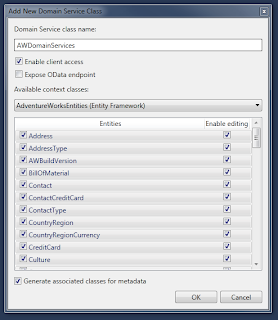Step 2: Add an Empty Web Project:
Step 3: Add Silverlight Class Library (works on SL5)
Step 4: Add MVVM light 5
Step 5: Link .Web to Silverlight Application:
.Web -> Properties -> Silverlight -> Add SilverLight Project
remove .aspx start file generated by the link (in this example MvvmRIASample.SLTestPage.aspx)
and rename MvvmRIASample.SLTestPage.html to index.html and make it start page.
Step 6: Add Folder Models to .Web (where the .emdx is created)
COMPILE!!!
Step 7: Add Folder Service to .Web
Step 8: Link .Core to .Web (WCF RIA Service Link) through .Core Properties
Step 9: Make .SL depend on .Core
Step 10: Add the same references that .Core has to .SL
- System.ComponentModel.DataAnnotations
- System.ServiceModel
- System.ServiceModel.DomainServices.Client
- System.ServiceModel.DomainServices.Client.Web
- System.ServiceModel.Web.Extensions
Step 11: Make the previous .DLL do NOT copy in LOCAL (in .Core) to avoid duplication in the final executable.
Step 12: Modify MainViewModel.cs (to test that everything is working correctly)
adding the following:
using MvvmRIASample.Web.Models;
using MvvmRIASample.Web.Services;
using System.Linq;
#region Welcome
public const string WelcomePropertyName = "Welcome";
private string _welcome = "";
public string Welcome
{
get
{
return _welcome;
}
set
{
if (_welcome == value)
{
return;
}
var oldValue = _welcome;
_welcome = value;
RaisePropertyChanged(WelcomePropertyName);
}
}
#endregion
public MainViewModel()
{
if (IsInDesignMode)
{
Welcome = "Design Data";
}
else
{
AWDomainServices context = new AWDomainServices();
context.Load(context.GetProductsQuery(), (result =>
{
if (!result.HasError)
{
Product first = result.Entities.FirstOrDefault();
if (first != null)
{
Welcome = first.Name;
}
}
}), null);
}
}
Add Authentication Service
Step 13: Add the following in web.config in .Web project
<!--<system.web>--> <!-- <compilation debug="true" targetFramework="4.0" />--> <authentication mode="Forms"></authentication> <roleManager enabled="true"></roleManager> <profile enabled="true"> <properties> <add type="System.Int32" defaultValue="10" name="DefaultRows"/> <!-- test --> </properties> </profile> <!-- </system.web>-->
Step 14: Add "Authentication Domain Service" to .Web (Services\AuthenticationDomainService.cs)
[EnableClientAccess] public class AuthenticationDomainService : AuthenticationBase<User> { } public class User : UserBase { public int DefaultRows { get; set; } }
And build the solution.
Step 16: Create an Test User using ASP.NET Web Site Administration Tool
Step 17: Manually create the class WebContext.cs in .Core
public sealed partial class WebContext: WebContextBase
{
partial void OnCreated();
public WebContext()
{
this.OnCreated();
}
public new static WebContext Current
{
get
{
return ((WebContext)(WebContextBase.Current));
}
}
public new User User
{
get
{
return ((User)(base.User));
}
}
}
Step 18: Configuring the Client for Authentication
in App.xaml.c
public App()
{
Startup += Application_Startup;
Exit += Application_Exit;
UnhandledException += Application_UnhandledException;
InitializeComponent();
/////////////////////// added
WebContext webContext = new WebContext();
webContext.Authentication = new FormsAuthentication();
this.ApplicationLifetimeObjects.Add(webContext);
}
private void Application_Startup(object sender, StartupEventArgs e)
{
/// Added Code
((WebAuthenticationService)WebContext.Current.Authentication).DomainContext = new MultiTier.Web.AuthenticationDomainContext();
this.Resources.Add("WebContext", WebContext.Current);
//////////////////
RootVisual = new MainPage();
DispatcherHelper.Initialize();
}
Step 19: Adding Login Functionality to the Client (step 19 is to add some code to see it works)
Add the following snippet to MainPage.xaml:
<TextBlock x:Name="WelcomeText" Visibility="Collapsed"></TextBlock>
<HyperlinkButton x:Name="LogoutButton"
Content="Logout"
Click="LogoutButton_Click"
Visibility="Collapsed">
</HyperlinkButton>
<Border x:Name="LoginBorder"
Margin="10,10,0,0"
BorderThickness="2"
BorderBrush="Black"
HorizontalAlignment="Left"
CornerRadius="15"
Padding="10"
Background="BlanchedAlmond"
Width="300">
<Grid HorizontalAlignment="Left">
<Grid.RowDefinitions>
<RowDefinition></RowDefinition>
<RowDefinition Height="30" ></RowDefinition>
<RowDefinition Height="30"></RowDefinition>
<RowDefinition></RowDefinition>
<RowDefinition></RowDefinition>
</Grid.RowDefinitions>
<Grid.ColumnDefinitions>
<ColumnDefinition></ColumnDefinition>
<ColumnDefinition></ColumnDefinition>
</Grid.ColumnDefinitions>
<TextBlock Grid.Row="0"
Grid.ColumnSpan="2"
Grid.Column="0"
FontWeight="Bold"
HorizontalAlignment="Left"
VerticalAlignment="Center"
Text="Log In Existing User">
</TextBlock>
<TextBlock Grid.Row="1"
Grid.Column="0"
HorizontalAlignment="Right"
VerticalAlignment="Center"
Text="User Name: ">
</TextBlock>
<TextBox x:Name="UserName"
VerticalAlignment="Center"
Grid.Row="1"
Grid.Column="1"
Width="100">
</TextBox>
<TextBlock Grid.Row="2"
HorizontalAlignment="Right"
Grid.Column="0"
VerticalAlignment="Center"
Text="Password: ">
</TextBlock>
<PasswordBox x:Name="Password"
VerticalAlignment="Center"
Grid.Row="2"
Grid.Column="1"
Width="100">
</PasswordBox>
<TextBlock x:Name="LoginResult"
TextWrapping="Wrap"
Visibility="Collapsed"
Grid.Row="3"
Grid.ColumnSpan="2"
Foreground="Red">
</TextBlock>
<Button x:Name="LoginButton"
Margin="0,5,0,0"
Grid.Row="4"
Grid.Column="1"
Content="Log In"
Click="LoginButton_Click">
</Button>
</Grid>
</Border>
and following codes to MainPage.xaml.cs
protected void OnNavigatedTo(NavigationEventArgs e)
{
SetControlVisibility(WebContext.Current.User.IsAuthenticated);
}
private void LoginButton_Click(object sender, RoutedEventArgs e)
{
LoginParameters lp = new LoginParameters(UserName.Text, Password.Password);
WebContext.Current.Authentication.Login(lp, this.LoginOperation_Completed, null);
LoginButton.IsEnabled = false;
LoginResult.Text = "";
}
private void LoginOperation_Completed(LoginOperation lo)
{
if (lo.HasError)
{
LoginResult.Text = lo.Error.Message;
LoginResult.Visibility = System.Windows.Visibility.Visible;
lo.MarkErrorAsHandled();
}
else if (lo.LoginSuccess == false)
{
LoginResult.Text = "Login failed. Please check user name and password.";
LoginResult.Visibility = System.Windows.Visibility.Visible;
}
else if (lo.LoginSuccess == true)
{
SetControlVisibility(true);
}
LoginButton.IsEnabled = true;
}
private void SetControlVisibility(bool isAuthenticated)
{
if (isAuthenticated)
{
LoginBorder.Visibility = System.Windows.Visibility.Collapsed;
WelcomeText.Text = "Welcome " + WebContext.Current.User.Name;
WelcomeText.Visibility = System.Windows.Visibility.Visible;
LogoutButton.Visibility = System.Windows.Visibility.Visible;
}
else
{
LoginBorder.Visibility = System.Windows.Visibility.Visible;
WelcomeText.Visibility = System.Windows.Visibility.Collapsed;
LogoutButton.Visibility = System.Windows.Visibility.Collapsed;
}
}
private void LogoutButton_Click(object sender, RoutedEventArgs e)
{
WebContext.Current.Authentication.Logout(this.LogoutOperation_Completed, null);
}
private void LogoutOperation_Completed(LogoutOperation lo)
{
if (!lo.HasError)
{
SetControlVisibility(false);
}
else
{
//ErrorWindow ew = new ErrorWindow("Logout failed.", "Please try logging out again.");
//ew.Show();
lo.MarkErrorAsHandled();
}
}










